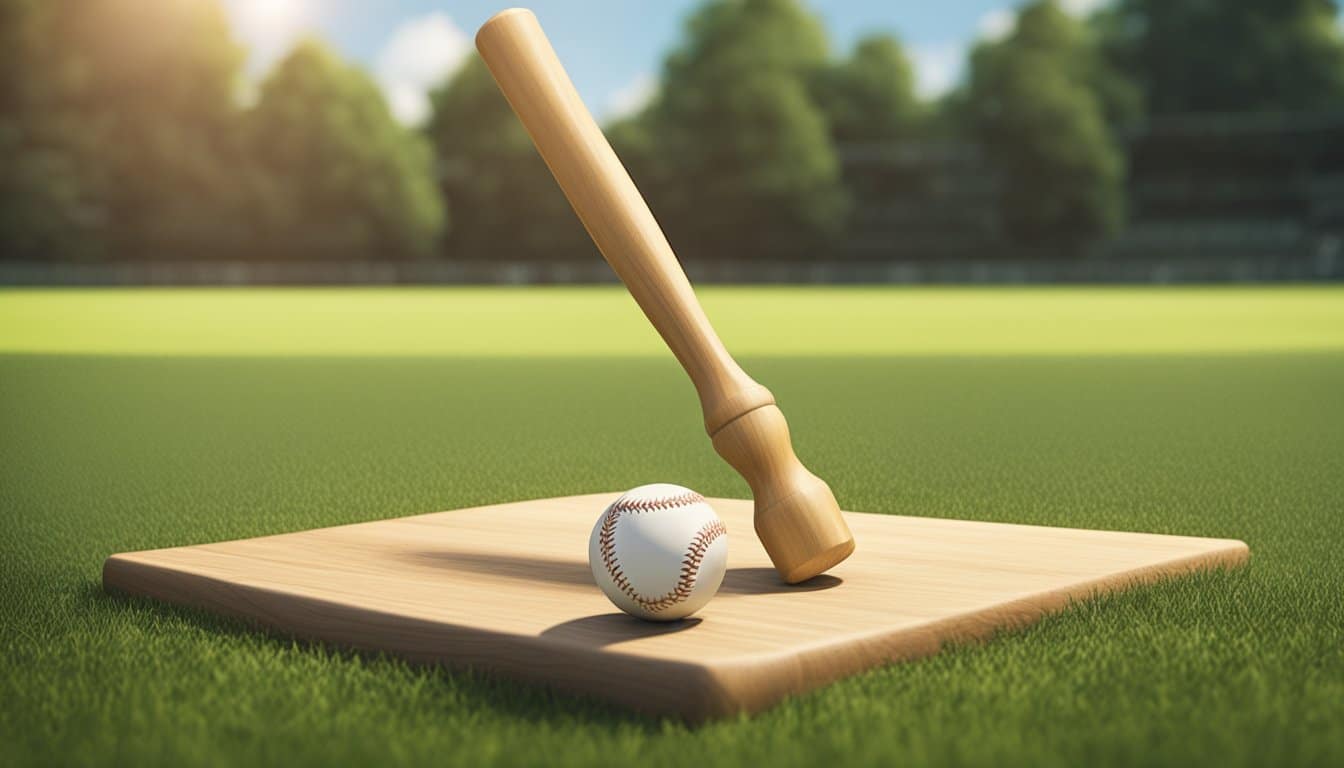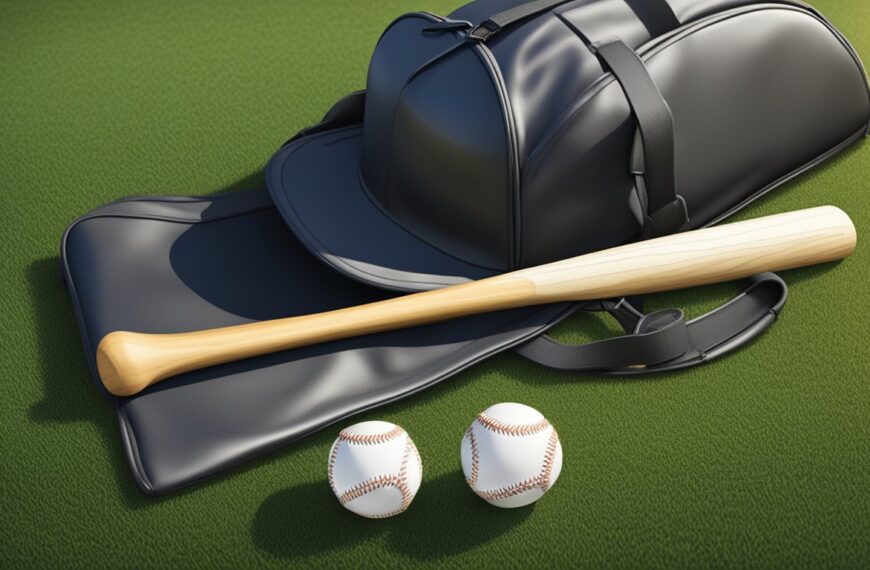Introducing young athletes to the world of baseball can be an exciting journey, and a fundamental part of that process is teaching effective batting techniques. A batting tee is an excellent tool for beginners as it allows young players to focus on their swing without the variable of a pitched ball. It aids in creating a solid foundation for their hitting skills, building confidence and muscle memory through repetitive practice.
Utilizing a batting tee helps young athletes develop a better understanding of swing mechanics, and it’s crucial to ensure the tee is set up correctly to mirror realistic pitch heights. As they grow comfortable with their batting stance and the basic swing mechanics, incorporating practical drills and techniques into their training sessions becomes essential. These drills should be designed to keep the athletes engaged and continuously improving their skills.
Key Takeaways
- A batting tee builds a strong foundation for a young athlete’s batting skills.
- Correct setup and use of the batting tee are critical for developing proper swing mechanics.
- Tailored drills and consistent practice routines are key in advancing young players’ batting capabilities.
Understanding the Batting Tee
https://www.youtube.com/watch?v=VBGjLcNTbLw&embed=true
The batting tee serves as an essential training tool for young athletes, facilitating the development of hitting skills through repetitive, focused practice.
Variants of Batting Tees
Batting tees come in various designs, each tailored to cater to different training needs and preferences. The Tanner Tee, notable for its patented Flextop design, allows the ball to sit with minimal interference, closely mimicking the in-flight path. Tees may vary in adjustability, with some accommodating a range of heights for different age groups. Portable tees are optimized for ease of transport, often featuring lightweight but durable materials, such as a mix of metal and rubber components.
Components of a Quality Batting Tee
A quality batting tee is characterized by robust durability and a stable base. Its construction should involve high-grade materials such as reinforced metal to withstand repetitive use. The upper portion, or the part that holds the baseball, is typically made from softer materials like rubber to minimize bat damage during swings. The inventor of the Tanner Tee, Joe Tanner, emphasized a tee that is both sturdy and forgiving, with a flexible top that helps prevent negative feedback during mis-hits.
Significance of a Batting Tee in Training
A batting tee is a significant training aid as it allows athletes to practice hitting without the need for a pitcher. This enables focus on form and repetition, leading to muscle memory development. It is particularly crucial for beginners to create a solid foundation for their swing mechanics. Moreover, the stationary setup of the tee encourages players to work on hitting balls at different heights and angles, translating to better performance against live pitching.
Setting Up the Tee
https://www.youtube.com/watch?v=diHt5j-rWjM&embed=true
To ensure a productive batting practice, the correct assembly and positioning of the batting tee are fundamental. Mastery begins with proper setup, allowing young athletes to focus on developing their swing mechanics and consistency.
Choosing the Right Location
Selecting an appropriate spot for tee work is crucial. One should look for a flat, even surface that is free of obstacles and provides ample space for the athlete to swing freely. Safety is paramount, so ensuring there’s enough distance from other players and objects is essential.
- Safe distance from others: Minimum 15 feet
- Surface type: Grass or turf
- Space requirement: Circular area with a 10-foot radius
Adjusting the Tee for the Hitter
The adjustable stem of the tee must be set to match the hitter’s specific strike zone. This can be finely tuned, but as a starting point, adjust the tee so that the ball sits at the midpoint of the hitter’s thigh. Young athletes vary in size, and therefore the tee’s height should be readjusted for each individual.
Adjustment Steps:
- Loosen the adjustment mechanism.
- Slide the stem to the appropriate height.
- Secure the setting for stability.
Stabilizing the Tee for Effective Use
A stable tee is necessary to mimic the precise feel of hitting a pitched ball. Ensure that the base is squarely grounded and, if necessary, weighted or buried slightly to prevent tipping. The stability of the tee directly affects the quality of practice and the development of the athlete’s skill.
- Check for: Even weight distribution
- Securing method: Sandbags or weights, if needed
- Post-practice: Re-check and adjust stability as needed
Batting Stance and Swing Mechanics
https://www.youtube.com/watch?v=keVyBnlHqCo&embed=true
The foundation of a successful hitter lies in mastering the intricacies of their batting stance and swing mechanics. Young athletes need to establish strong fundamentals to develop a swing that is both powerful and precise.
Fundamentals of a Proper Stance
A proper batting stance is essential for achieving balance, vision, and readiness to hit. The athlete should stand with feet shoulder-width apart, knees slightly bent, and weight evenly distributed on both legs. Hands should be at shoulder height, with the bat angled slightly over the shoulder, allowing for quick adjustments and a fluid swing.
- Balance: Even weight distribution on both legs
- Vision: Eyes level, focused on the pitcher
- Readiness: Knees slightly bent, hands at shoulder height
Developing Swing Mechanics
Swing mechanics are crucial in connecting the bat with the ball effectively. The swing should be a smooth, continuous motion where the hitter rotates their hips and shoulders simultaneously, leading with the hands and the bat following. Muscle memory plays a significant role here, and athletes should practice repetitive drills to engrain these movements.
- Hip-shoulder coordination: Rotate hips and shoulders together
- Bat path: Lead with hands, keeping the bat level through the strike zone
- Practice: Repetitive drills to build muscle memory
Adapting Tee Work to Enhance Swing
Batting tee practice allows young athletes to focus on their swing without the variable of pitch speed or location. It’s an opportunity to work on hand-eye coordination and refine hitting mechanics. To increase bat speed, the athlete should practice hitting balls off the tee with intentionality, focusing on driving through the ball with force.
- Hand-eye coordination: Focus on hitting the ball squarely
- Hitting mechanics: Consistent practice to reinforce proper technique
- Bat speed: Emphasize driving through the ball
Practical Drills and Techniques
https://www.youtube.com/watch?v=hXWwZkQ7rII&embed=true
Effective batting tee use can significantly improve young athletes’ hitting abilities. Through focused drills and proper technique, players can isolate contact points, progress through various drills, and integrate skills into live pitching situations.
Isolating Contact Points
To optimize a player’s ability to hit the ball with the sweet spot of the bat, isolating specific contact points within the strike zone is crucial. The following drills help athletes refine their precision:
- Inside Pitch Drill: Position the tee internally near the batter’s front hip to encourage proper hand path and contact on inside pitches. Athletes should aim to drive the ball directly up the middle or pull it to the field corresponding to their dominant side (right field for right-handers and left field for left-handers).
- Outside Pitch Drill: Set up the tee on the outer half of the plate, guiding hitters to extend their arms and make contact opposite to their dominant side (left field for right-handers and right field for left-handers). Emphasize a direct line through the ball to avoid casting the bat.
Progressing with Various Drills
Progressive drills designed around the batting tee can enhance an athlete’s approach and hitting mechanics progressively:
- Soft Toss Variations: Initiate with soft toss drills where a coach or machine gently tosses balls towards the batter’s strike zone. Progress to more challenging tosses including high and low pitches to simulate game-like conditions.
- Height Adjustments: Experiment with tee height to train hitters to adjust to pitches in various vertical locations within the strike zone. This builds adaptability and extends their comfort zone to a variety of pitch locations.
Integration with Live Pitching
Once young athletes demonstrate proficiency with static tee drills, they can transition to facing live pitching. This phase focuses on applying the mechanics and timing developed during tee work:
- Controlled Batting Practice: Begin with controlled batting practice, where pitchers throw at a moderate speed, allowing hitters to implement what they’ve learned from tee drills in a live situation.
- Pitch Recognition: Introduce a drill where players call out the type of pitch (“inside,” “outside,” “high,” “low”) as they swing, enhancing their ability to read the pitch in real-time.
By consistently utilizing these drills and techniques, young athletes can develop into proficient hitters. Practice, combined with a systematic approach to training, lays the groundwork for success at the plate.
Training Sessions and Routines
https://www.youtube.com/watch?v=ELo4zAOKTkg&embed=true
Effective batting tee use in young athletes revolves around structured practices, skill level adjustments during training, and keeping track of progress and outcomes to ensure consistent improvement.
Structured Practice for Consistency
Athletes should follow a routine schedule that emphasizes repetitive practice focused on fundamental batting techniques. This includes:
- Monday, Wednesday, Friday: Main batting tee drills, 30 minutes each session
- Tuesday, Thursday: Focus on stance and swing mechanics, 20 minutes each session
- Weekends: Optional review of the week’s training, 15 minutes
Ensuring athletes engage in regular drills helps in building muscle memory and refining their batting skills.
Skill Level Adjustment in Training
Coaches must assess and adjust training intensity and complexity based on the athlete’s skill level. For instance:
- Beginner: Focus on contact with the ball using a stationary tee.
- Intermediate: Introduce slight movement to the tee to mimic varied pitches.
- Advanced: Complex drills, such as changing tee heights and angles for pitch simulation.
Adjustments ensure that athletes are always challenged but not overwhelmed.
Tracking Progress and Outcomes
Tracking an athlete’s progression is vital for sustained improvement. Coaches and athletes can use a simple table like the one below to monitor progress:
| Week | Batting Average | Quality Contact Rate | Notes |
|---|---|---|---|
| 1 | .250 | 60% | Adjust stance |
| 2 | .300 | 70% | Improved grip |
| 3 | .320 | 75% | Faster swing |
By documenting these metrics, athletes and coaches can clearly see where improvement is occurring and identify areas needing additional focus.
Additional Equipment and Maintenance
To optimize batting practice, it’s important to consider the right supplementary gear and proper upkeep of the batting tee. This ensures longevity and effectiveness in training sessions.
Supplementing the Tee with Other Equipment
Baseball and softball players often enhance their training by incorporating additional items. For a more comprehensive practice setup, one might consider adding the following to their arsenal:
- Batting Cage: A batting cage provides a contained space for focused batting practice. Pairing a cage with a batting tee allows players to work on their swing without fetching balls.
- Premium Softballs/Baseballs: Quality balls offer realistic feedback on contact.
- Equipment Bag: A durable bag is crucial for transport and can hold the batting tee, balls, and other gear.
- Tanner Heavy Tee: Known for its sturdiness, a Tanner Heavy tee withstands repetitive use, making it a wise investment for serious athletes.
Maintaining and Storing Your Batting Tee
Proper care extends the life of a batting tee. Follow these maintenance guidelines:
- Post-Use Inspection: Check for any damage and tighten any loose locks or connections.
- Regular Cleaning: Wipe down the tee to prevent buildup of dirt and grime.
- Storage: Disassemble the tee if it’s designed to break down, and store it in a cool, dry place. If it’s lightweight, storing it in an equipment bag can protect it during travel.
By adhering to these maintenance steps, athletes ensure their equipment remains in top condition for the next training session.
Common Challenges and Solutions
https://www.youtube.com/watch?v=nJ1SMAQN9Oo&embed=true
When introducing young athletes to batting tee use, coaches often encounter a few recurring hurdles. Addressing these early on ensures a smoother learning curve and better overall development.
Overcoming Beginner Difficulties
Beginners may struggle with poor swing mechanics or ineffective stance at the tee. Coaches should:
- Emphasize the stance: Ensure they stand with feet shoulder-width apart, knees slightly bent, and weight balanced.
- Correct the swing: Work on keeping the head still, eyes on the ball, and leading with the hips to generate power.
Beginners may also have questions about the process or feel resistance to repetitive practice. To address this, coaches can:
- Provide clear explanations of the benefits.
- Use visual aids to demonstrate proper techniques.
- Encourage questions to understand and resolve specific concerns.
Adjusting to Varying Pitch Locations
Bad habits like swinging at inappropriate height and depth of the ball can set in quickly. Coaches should address this by:
- Changing the tee height: Regularly adjust the tee to simulate various pitch locations.
- Encouraging athletes to practice swinging through the zone, helping them adapt to different pitches.
Dealing with Equipment and Environmental Factors
Young athletes might face distractions from other players or environmental factors like wind and sun. To help them maintain focus:
- Use screens or barriers to limit visual distractions.
- Schedule practice during times when environmental factors are minimal.
Coaches also need to check and adjust equipment regularly. For a consistent experience:
- Ensure the batting tee is stable and at the correct height.
- Replace damaged equipment promptly to prevent the development of bad habits.
Engaging the Young Athlete
Proper engagement of young athletes in the use of batting tees lays the foundation for both skill development and a love for the game. This involves fostering a positive environment that builds confidence and integrates valuable guidance from those around them.
Building Confidence and Enjoyment
For any child stepping onto the base for tee ball or coach pitch, confidence is crucial. Coaches must ensure that training aids, like batting tees, are used in a way that encourages a young athlete to trust in their burgeoning abilities. One method to promote this is through a structured yet enjoyable approach to practice that emphasizes consistent technique.
Techniques to build confidence include:
- Utilizing positive reinforcement when the child makes contact with the ball, regardless of the outcome.
- Setting small, achievable goals during practice to generate a sense of progression and accomplishment.
The end goal is to cultivate not just a skilled player, but one who finds joy every time they step up to the tee.
Incorporating Feedback from Coaches and Players
Feedback is a pivotal part of the learning process, particularly when introducing young athletes to new skills. It’s essential for coaches to provide constructive criticism that is both understandable and actionable for the child.
Feedback best practices:
- Offering immediate and specific feedback on the child’s batting technique.
- Encouraging peer feedback, which can bolster camaraderie and collective growth among young players.
By making feedback an integral part of practice, players can adapt and refine their techniques effectively, reinforcing their training and preparation for game situations.
Advanced Techniques and Strategies
https://www.youtube.com/watch?v=6AX6maJAwx4&embed=true
Mastering advanced batting tee techniques requires a focused approach to specific aspects of hitting mechanics which are crucial for those looking to make the leap to the big leagues.
Fine-Tuning Hitting for Experienced Players
Experienced players seeking to elevate their hitting game must concentrate on the minute details of their swing. Weighted bats can be utilized to enhance strength and refine the hitter’s swing path. By practicing with these bats, players can develop muscle memory for more powerful, consistent contact. Attention should also be given to launch angle, which is pivotal in maximizing the distance of each hit. Players should position the batting tee at various heights and positions to simulate pitches across the strike zone. This strategy helps in understanding how to adjust swings for pitches in different locations.
- Inside Pitch: The tee should be placed closer to the hitter. They must keep their hands close to their body and aim to drive the ball, targeting the hitting deck.
- Outside Pitch: The tee is placed further away. The hitter should focus on extending their arms and driving the ball to the opposite field.
Transitioning from Tee Work to Game Situations
Once players have practiced extensively on the tee, the next step is applying these skills in live games. Simulated game scenarios can bridge the gap between tee work and actual games. A recommendation for coaches is to mix tee work with soft toss and live pitching drills to acclimate hitters to varying speeds and pitch placements. Advanced hitters should practice hitting on the tee with the same intensity and focus they would use in a game situation to ensure that the batting mechanics honed on the tee translate effectively to real-game pressure.
- Drills should start with the hitter visualizing game-like scenarios, reacting to where the tee is placed, as if it were a live pitch.
- A progressive routine might start with solid contact and build up to situational hitting, such as handling the inside pitch with runners on base or going opposite field to defeat a shift.
Purchasing Recommendations
Selecting the right batting tee is crucial for enhancing the training experience of young athletes. It involves balancing quality and cost to ensure long-term satisfaction and performance improvement.
Identifying the Best Batting Tees
When looking for the best batting tee, durability is key. Tanner Tees stand out in this regard, offering a sturdy base and flexible top that can withstand repeated use. They are often lauded for their longevity and the ability to retain their form even after numerous batting sessions. A high-quality tee should not only be durable but also adjustable to accommodate different height requirements.
- Durability: Search for tees made from high-grade materials such as heavy-duty rubber or reinforced metal.
- Adjustability: Ensure the tee’s height can be easily adjusted to cater to various strike zones.
Considering Performance and Budget
While the best batting tee might imply the most expensive one, this is not always the case. Young athletes and their guardians should weigh the tee’s performance features against their budget. A tee that offers both is considered a valuable purchase.
- Cost-efficiency:
- Affordable: Look for a tee within your budget that does not compromise on essential features.
- Investment: Consider tees that may cost more initially but are likely to last longer due to superior build quality.
- Performance:
- Stability: A heavier base can provide the tee with more stability and reduce the chances of it tipping over.
- Compatibility: Ensure the tee is suitable for the athlete’s age and skill level for effective practice sessions.
Safety Precautions and Guidelines
When introducing young athletes to batting tee use, safety is a primary concern. Coaches and parents should enforce these guidelines to ensure a secure environment:
Personal Protective Equipment (PPE):
- Helmet: A batting helmet is mandatory to protect the head from accidental impacts.
- Gloves: Batting gloves provide a better grip and protect the hands.
Tee Stability:
- Base Check: Ensure the tee’s base is weighted or staked down properly to prevent tipping.
- Surface: Use the tee on a flat, even surface to maintain stability during use.
Equipment Inspection:
- Regularly inspect the tee for any damage such as cracks or sharp edges that could pose a risk.
Proper Technique:
- Young athletes should be taught the correct stance and batting technique not only for performance but also to prevent strain injuries.
Supervision:
- Always have an adult supervising to quickly address any safety issues that arise.
Surrounding Area:
- Keep the surrounding area clear of other individuals and objects to avoid unintended impacts with the bat or stray balls.
Use of Properly Sized Equipment:
- Using a bat that is too heavy or too long can lead to loss of control, so it’s important to size the bat according to the child’s age and strength.
Emergency Procedures:
- Coaches and supervisors should be aware of first aid procedures and have access to a first aid kit in case of an accident.
Conclusion
Training with a batting tee provides a solid foundation for young athletes to hone their hitting skills. The methodical practice with a tee can be both a powerful and a fundamental component in a player’s journey towards success in baseball or softball.
A coach plays a crucial role in this process, offering guidance on the correct stance, swing path, and contact points. Consistent practice helps athletes understand the dynamics of their swing and develop muscle memory.
Key Takeaways:
- Batting tees assist in building consistent hitting mechanics.
- Regular practice on the tee can lead to noticeable improvements in actual game situations.
Considerations for Athletes:
- Use the tee to work on different hit locations.
- Integrate batting tee drills into a routine workout.
Coaches should emphasize quality over quantity to ensure each swing is purposeful, reinforcing optimal hitting technique. They are tasked with the responsibility to assess and adjust the training regimen to align with an athlete’s progress and challenges.
By integrating tee work into regular practice, young athletes set a foundation for their development as successful hitters. The patience and dedication invested in this training will be reflected in their performance at the plate.
Frequently Asked Questions
https://www.youtube.com/watch?v=KW6qe5lKCgs&embed=true
Improving young athletes’ batting skills begins with structured tee work and consistent practice. By focusing on specific drills and techniques, players can refine their swing and gain confidence at the plate.
What drills can help young baseball players improve their hitting skills using a batting tee?
They should practice the “walk-through drill” to enhance weight transfer and the “inside pitch drill” for quicker bat path. Both drills reinforce the key components of a powerful, efficient swing.
How can coaches effectively teach proper swinging techniques to children aged 6 to 8 years old?
Coaches can focus on fundamentals like stance, grip, and balance using verbal cues and repeated demonstrations. Simplified language and visual aids, like diagrams on the ground, can make instructions more digestible for this age group.
Can using a Tanner Tee aid in the development of a young athlete’s batting abilities, and if so, how?
A Tanner Tee, due to its sturdy and adjustable design, allows for various swing planes and heights, which can promote better hand-eye coordination and hitting different pitch locations.
What are the benefits of including tee work in a youth softball training regimen?
Tee work in youth softball training emphasizes hand-eye coordination, swing consistency, and muscle memory. It provides an opportunity for players to focus on their swing mechanics without the variable of a pitched ball.
What methods are recommended for increasing bat speed in young baseball players?
To increase bat speed, young players should focus on wrist-strengthening exercises, underload and overload training with various weighted bats, and rotational exercises to enhance core strength.
What are the key fundamentals to focus on when introducing tee hitting to novice players?
When introducing tee hitting to novice players, emphasize a balanced stance, proper grip, and a level swing path. Encouraging a focus on hitting through the ball rather than to it helps in developing solid contact skill.













